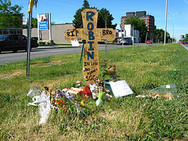Petula Dvorak puts a few minutes’ convenience over Montgomery residents’ lives

Photo by Peter Blanchard on Flickr.
How many people worry about strangers kidnapping their children and lament the loss of life in Iraq, but then put other people and their children in danger the moment they get on the road by speeding, and become apoplectic if the government tries to get them to stop?
Washington Post columnist Petula Dvorak demonstrated this “windshield perspective,” which we sometimes call “Entitled Driving Journalist Syndrome,” with a venomous column today. The target of her hate? Speed cameras.
She cheers the recent vandalism and arson against speed cameras, quoting residents pleased this destruction of county property. She calls the cameras “vile devices,” a “gargantuan gotcha,” “horrid contraptions,” and “a speed tax.”
Facts? Who cares. She introduces the question of effectiveness with the evidently non-objective assertion, “Whether they actually reduce [crashes] is questionable.”
Officials said collisions went down almost 30 percent in the sites near the cameras. But others argue they aren’t very effective at curbing reckless driving.
Who are those others? Oh, just some guy in a BMW who has gotten a bunch of tickets. Because we all know that some random person on the street clearly knows whether a policy is effective simply by taking a guess. The fact is, cameras work.
The problem is that this guy in the BMW might be the next person to kill another human being in Montgomery County. He likes to speed. He’s breaking the law. And the laws are there for an important reason: to protect people besides himself, or besides Dvorak, who clearly likes to speed herself.
Drivers like the BMW guy killed four people in one week in Montgomery County last month. But Petula Dvorak didn’t write a column about the tragedies that took those four lives and destroyed their families. She wrote about how it’s so unfair Montgomery County wants to do something about it, since it creates some inconvenience and maybe a little cost for average people like her who just want to shave a minute or two off the trip to the store. That’s what’s important, right?
Dvorak gets particularly irate over the way the fines are relatively low and there are no points on the license, arguing that it’s an underhanded way of discouraging people from fighting the tickets. She waxes more nostalgic about “the gut-wrench of hearing a siren behind you, seeing those lights in the rearview and the officer’s long walk to your car as you squirm.” She even worries about revenue at the donut shops near where police officers used to catch speeders, before cameras allowed them to focus on other crimes.
Actually, if facts mattered, Dvorak might have found out that frequent enforcement with low-level punishment is a more effective way to stop crime than infrequent enforcement with big penalties. If someone shoplifts regularly, gets caught only once out of a hundred times, but faces a year in prison the one time they do, it’s not a very effective deterrent.
Most people who do it will try it once, get away with it, try it again, get away with it, and get into the habit not really considering the danger of getting caught. Those who do get nabbed end up facing punishment that seems totally disproportionate to the crime, and that’s unfair.
Instead, if a shoplifter was detected half the time but the punishment were fairly small, research like Mark Kleiman’s — that stuff that actually finds out information in a more reliable way than asking people on the street — shows that the rate of shoplifting declines much more. The same goes for cameras. If people are much more likely to get caught but pay relatively little, it reduces speeding.
Because reducing speeding is the purpose. It’s an important purpose. Unfortunately, Dvorak makes absolutely no mention in her article about the value of cutting speeding or the dangers speeding poses.
Sure, there are some problems with speed camera programs. It’s true that many counties make a lot of money off the cameras, and that leads to some warped incentives. Sometimes governments place them where it will bring in more revenue instead of where there’s a greater safety risk. We’ve even agreed with AAA when they’ve criticized those types of placements.
Steve Offutt suggested forbidding governments from making money on cameras, by requiring that revenue be distributed back to residents. That would be a good way to fight the problems with speed cameras. The question is, do opponents of speed cameras really object to the revenue-raising nature, or just to being forced to follow the law?
Dvorak asks readers to email locations of the “sneakiest, most loathsome” cameras at dvorakp@washpost.com. Instead, why don’t you email her the locations of the most dangerous spots for pedestrians and bicyclists in Montgomery County caused by speeding drivers. Ask her to support speed cameras in those locations, before more people get killed.
And ask Dvorak to write a column about Samira Kelly and her 16-month-old daughter in Aspen Hill, or the many other people hit or killed in Montgomery County whose deaths might have been prevented or injuries avoided or lessened had some speed cameras taught them to follow the law and ease off the pedal.
